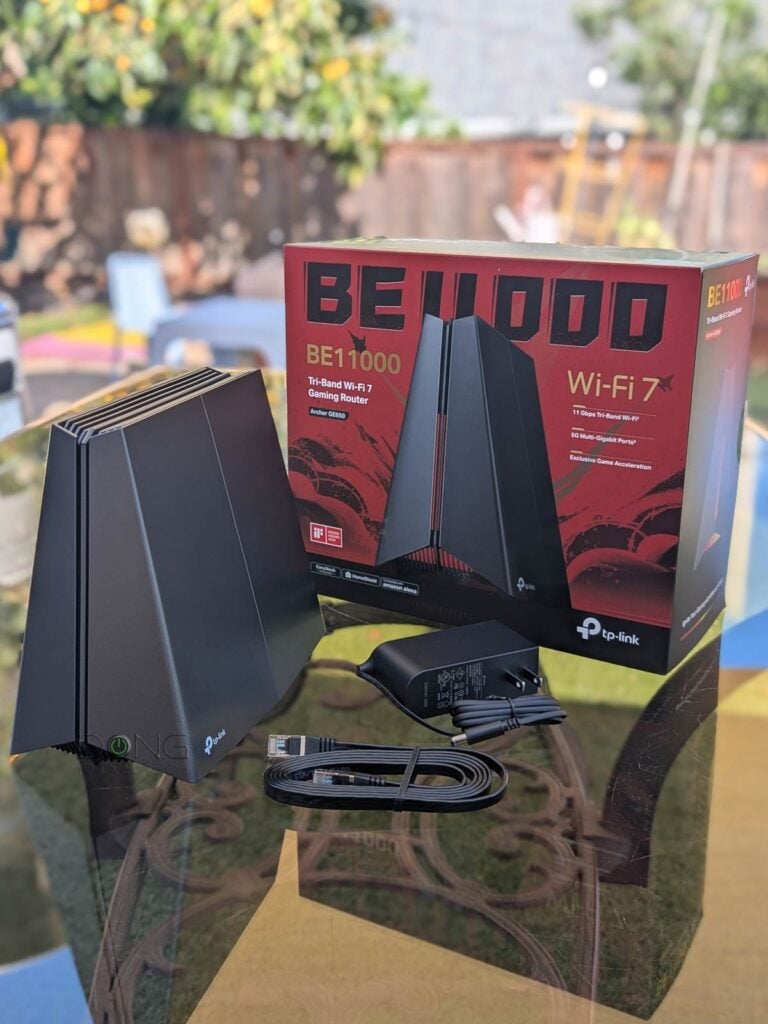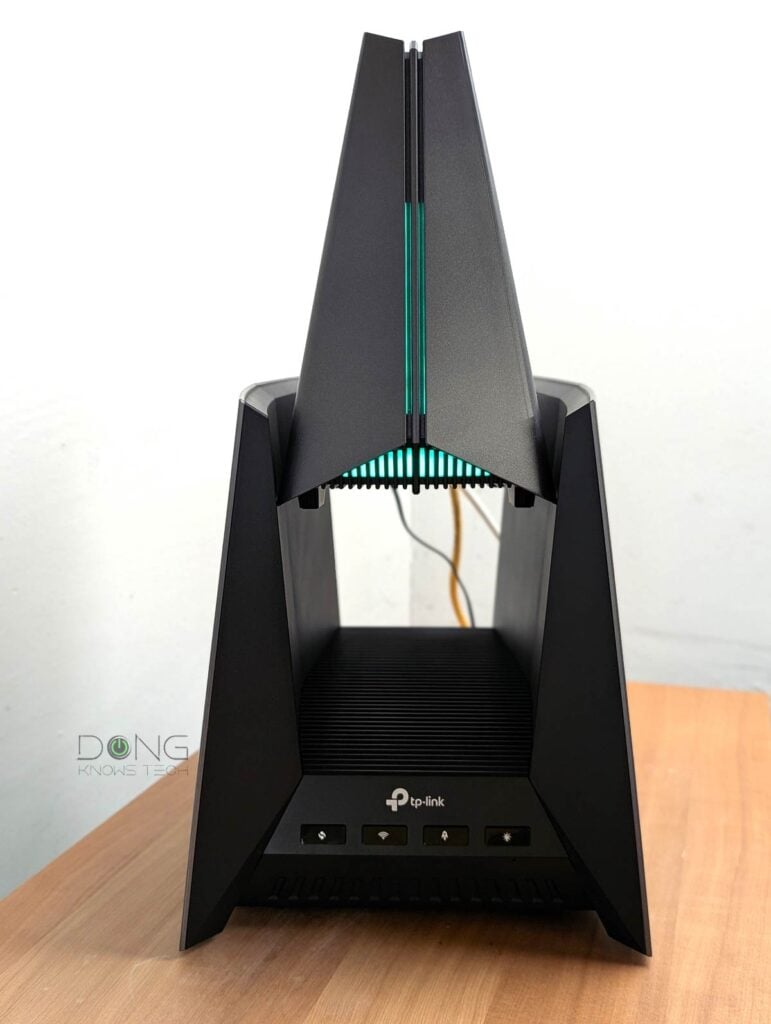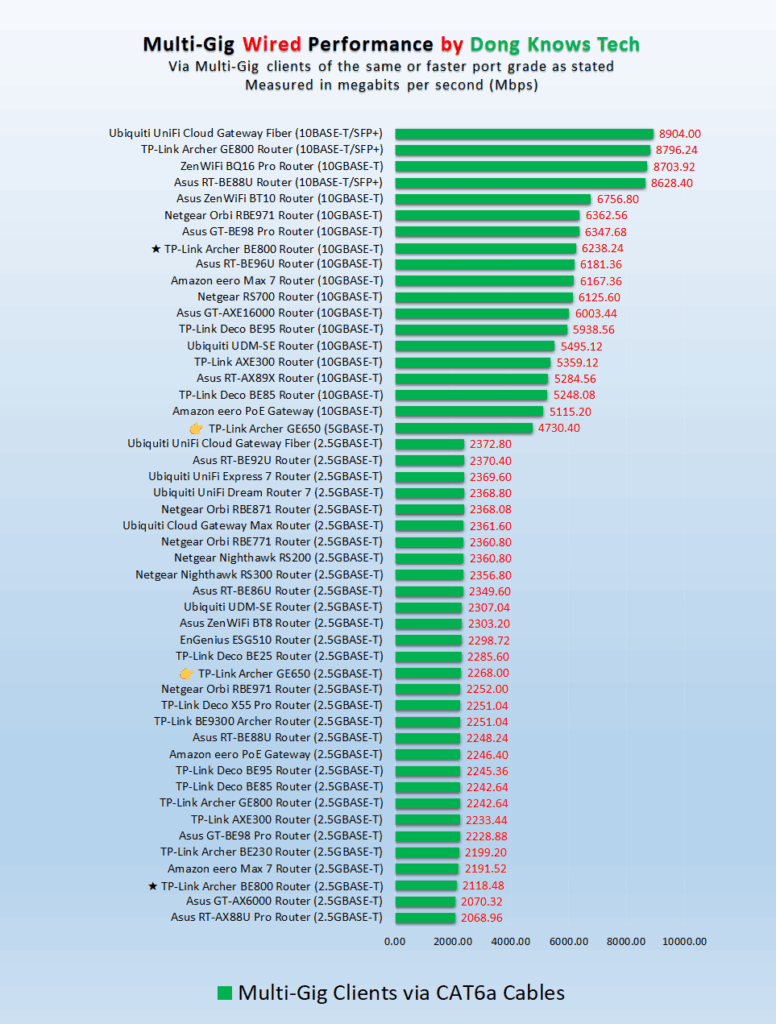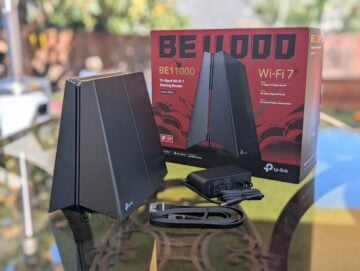The Archer GE650, first announced at CES 2025, is in many ways the lesser version of TP-Link’s first Wi-Fi 7 gaming router, the Archer GE800.
And that’s not necessarily a bad thing. The new router is much more compact while delivering a similar experience as far as Wi-Fi is concerned for those with entry-level multi-Gigabit broadband.
Here’s the bottom line: If you’re looking for a “real” gaming router from TP-Link and don’t have lots of space for a massive piece of networking hardware, the Archer GE650, with its fair share of shortcomings, is an excellent alternative. Consider it today!
Dong’s note: I first published this post as part of CES 2025 coverage when the router was announced, and updated to an in-depth review after thorough hands-on testing on May 23, 2025.

Archer GE650: A compact yet powerful enough Wi-Fi 7 gaming router
The new Archer GE650 is one of a handful of gaming routers from TP-Link. However, it’s actually the second actual gaming route besides the GE800. That’s because, like the more powerful predecessor, it, too, comes with real gaming-related features.
Specifically, per TP-Link, on the gaming front, it has:
- Game Accelerator:
- Game Applications Boost: An application-based QoS feature that automatically optimizes games.
- Game Server Acceleration: The router supports WTFast gaming private network, allowing subscribers to connect the router to the GPN as a client.
- Gear Acceleration: A client-based QoS feature that allows for prioritizing a particular connected client, including game consoles.
- Accelerate Game Devices with Gaming Port: Its 5Gbps LAN is designed to be automatically prioritized for games.
- Game Port Forwarding: A port-forwarding feature that helps users create entries for specific game titles among about 100 popular games. Users can also manually add a game’s port requirement.
- Game Detector: A feature that quickly tests the latency of certain games’ servers in real time to help users find one with the best experience.
Other than that, Game Statistics is a handy feature that shows information on titles recently played within the network, and “Game Diagnostics” is simply a fancy label for a ping tool.
Other than the support for WTFast, which I don’t have a subscription to, I tried all of the mentioned features briefly, and they worked as intended. It’s worth noting that all of the QoS-based features can be achieved on other “non-gaming” routers if you know how to do the parameters manually. That said, the convenience is a welcome bonus.
Like the GE800, the GE650 comes with programmable vertical RGB lighting on its front that grows into a glow on its underside. So, the router has everything to qualify itself as a gaming router, from the firmware-based features to eye-catching exterior design touches.


An eye-catching and much more compact design, with no 10Gbps ports
The Archer GE650 shares a similar look to the GE800 from the sides, but from the front and back, it now tapers toward the top to look like a rocket. Most importantly, it’s a much more compact device. In fact, it’s lanky enough to fit in the gap between the previous model’s massive antennas.
The small size also means it has no room for an internal fan, which means it won’t be as noisy, and no moving parts generally mean fewer potential problems. TP-Link told me the new router has a better thermal design and won’t become hot, either, which proved to be true during my trial. It became only slightly warm to the touch after hours of heavy operation.
So, the question is, if the compact fanless design is a good thing overall, what makes the GE650 a “lesser” version of the GE800? Two things.
First and also the most significant, it has no 10Gbps ports. Instead, it comes with two 5Gbps ports (one WAN and one LAN) and three 2.5Gbps LAN ports. And secondly, on the Wi-Fi front, it features the mid-tier 2×2 grade with half the bandwidth compared to the older cousin.
The table below shows the hardware details and real-world power consumption of the two.

Hardware specifications: TP-Link Archer GE650 vs. Archer GE800
 |  | |
|---|---|---|
| Model | TP-Link Archer GE650 | TP-Link Archer GE800 |
| Dimensions | 7.6 x 7.6 x 4.5 in (193.04 x 193.04 x 114.3 mm) | 11.5 × 8.1 × 8.8 in (292 × 207 × 224 mm) |
| Weight | 2.45 lbs (1.11 kg) | 4.87 lbs (2.21 kg) |
| Processing Power | TBD | Quad-core CPU, 2GB RAM |
| Wi-Fi Bandwidth | Tri-band BE11000 | Tri-band BE19000 |
| 1st Band (channel width) | 2×2 AX: Up to 574Mbps (20/40MHz) | 4×4 2.4GHz BE: Up to 1376Mbps (20/40MHz) |
| 2nd Band (channel width) | 2×2 5GHz BE: Up to 4323 Mbps (20/40/80/160/240MHz) | 4×4 5GHz BE: Up to 5760Mbps (20/40/80/160MHz) |
| 3rd Band (channel width) | 2×2 6GHz BE: Up to 5764Mbps (20/40/80/160/320MHz) | 4×4 6GHz BE: Up to 11520Mbps (20/40/80/160/320MHz) |
| Backward Compatibility | 802.11a/b/g/n/ac/ax/axe Wi-Fi | |
| Wireless Security | WPA / WPA2 / WPA3 | |
| Multi-Link Operation (MLO) | Yes | |
| Automated Frequency Coordination (AFC) | No | |
| Web User Interface | Yes | |
| Mobile App | TP-Link Tether (optional) | |
| Real Gaming-Related Features | Yes | |
| Operating Roles | Router (default) or Access Point | |
| Mesh-Ready | Yes (EasyMesh) | |
| USB Port | 1x USB 3.0 | |
| Gigabit Port | None | |
| Multi-Gig Port | 2x 5Gbps 3x 2.5Gbps | 1× 10GBASE-T 1x 10GBASE-T/SFP+ Combo 4× 2.5 2.5GBASE-T |
| Link Aggregation | Yes (LAN only) | |
| Dual-WAN | No | |
| VPN Server Support | OpenVPN, PPTP, L2TP/IPSec, WireGuard | |
| VPN Client Support | Yes (standard and WTFast GPN) | |
| VLAN | VLAN tagging only | |
| Internal Fan | No | Yes |
| Power Input | 100-240V | |
| Power Consumption (per 24 hours) | ≈ 315 Wh (as tested) | ≈ 585 Wh (as tested) |
| Release Date | February 27, 2025 | June 27, 2024 |
| Firmware (at review) | 1.1.0 Build 20250430 | 1.1.3 Build 20240528 |
| US Launch Price (Compare street prices) | $349.99 | $599.99 |


As shown in the table above, the Archer GE650, for the most part, is a lesser version of the GE800. However, thanks to the compact design, it might beat the older cousin in usability. The lack of noise alone can be a great bonus.
GE650: A typical Wi-Fi 7 router in TP-Link’s Archer family
While classified as a gaming router, the Archer GE650 is, first and foremost, a typical Archer router. As such, it’ll likely have the same firmware as the rest of the lineup.
Specifically, you can access its web user interface via the default IP address, 192.168.0.1, for setup and ongoing management, the way you would any standard Wi-Fi router.
In addition to the gaming features mentioned above, the router is expected to have the standard set of networking features, including Dynamic DNS, port forwarding, VPN (server or client), and all options for WAN access (dynamic, static, PPPoE, etc). Additionally, it comes with the basic version of HomeShield, which includes QoS and light parental control, with a more advanced version and online protection available via premium add-ons, as shown in the tab below.
| Security | Security+ | Total Security Package | |
|---|---|---|---|
| Coverage | At home | At home and on the go | |
| Availability | Included with all TP-Link Archer or Deco routers | Paid subscription | |
| Monthly Price | Free | $4.99 | n/a |
| Annual Price | Free | $35.99 | $69.99 |
| Mobile App Required | Yes | ||
| Features | Router security scan, wireless security scan, IoT device identification, Guest network, Camera security, Wi-Fi access control, Device isolation, Quality of Service (QoS) | All features of Security, plus: Web protection, Intrusion prevention, IoT protection, comprehensive report | All features of Security+, plus: Antivirus protection for PCs and mobile devices, Unlimited VPN, Password management for PCs and mobile devices. |
| Notes | Unavailable when the router (or mesh system) is working in the access point (AP) mode. Internet Security is provided by Norton 360 Deluxe TP-Link Edition, F-Secure Total, or Avira Prime, depending on the router model. | ||
| Standard | Advanced PC | Total PC | |
|---|---|---|---|
| Coverage | At home | At home and on the go | |
| Availability | Included with all TP-Link Archer or Deco routers | Paid subscription | |
| Monthly Price | Free | $2.99 | TBD |
| Annual Price | Free | $17.99 | TBD |
| Mobile App Required | Yes | ||
| Features | Create profiles, Preset age template, Pause the Internet, Content filter by URL, block specific websites, Bedtime, Insight report | All features of Standard, plus: Flexible bedtime, Time limits, Office time, Time reward, Family time, Blocked apps, App time limits, Always allowed apps, Safe search, YouTube restrictions, Comprehensive insights and reports | All features of Advanced PC, plus: KidShield app for Parental Controls on the go, Device settings management, Payment management, Lock device, Keep track of locations, Additional insights and reports |
| Notes | Not available when router (or mesh system) is working in the access point (AP) mode | ||
In terms of Wi-Fi 7 support, like previous Archer models, the GE650 has MLO right out of the box. It’s worth noting that the router only features MLSR MLO, meaning it’ll autoswitch between 5GHz and 6GHz to deliver the best connection. As for the AFC feature, it wasn’t available yet during my testing—it might or might not be added later via a firmware update. According to the way Wi-Fi 7 has panned out, though, I’d not count on its availability. At least, not anytime soon.


That said, here’s what the router has to offer in terms of SSID:
- A primary SSID for each of the three bands, or you can use an SSID for all of them via Smart Connect.
- An MLO SSID that combines the 5GHz and 6GHz into a single link.
- A Guest SSID for each of the bands.
- An IoT SSID for each of the 2.4GHz and 5GHz bands.
Overall, other than the gaming portion, the GE650 is a typical Archer router and only differentiates itself in real-world performance. And the router performed well in my testing.
TP-Link Archer GE650: Excellent performance, for the specs
Without 10Gbps ports and featuring mid-tier Wi-Fi 7, I didn’t expect the GE650 to outdo its predecessor in performance, and it didn’t in most cases. Still, the router proved impressive. In fact, its network-attached storage (NAS) performance when hosting a portable SSD was better than that of the more powerful Archer GE800.


With close to 300MB/s for reading and almost 250MB/s for writing, the router has enough to handle a small home’s network storage needs, which, apart from data sharing, also features media streaming and Time Machine backup support.
Its wired performance was also excellent for a router that features 5Gbps and 2.5Gbps Multi-Gig grades. In fact, its 2.5Gbps wired performance was slightly higher than that of the GE800.

In terms of Wi-Fi, the GE650 simply couldn’t compete with other 4×4 routers or those with 10Gbps ports. Still, it generally sustained at Gig+ at close range and around Gigabit at 40 feet (≈ 13 meters) away. Like most routers with MLSR MLO, the gaming router’s performance didn’t benefit in terms of data rate when this feature was turned on. However, that’s to be expected.


The Archer GE650 proved to be a pleasant surprise in terms of range. Considering its compact size, I thought it’d have less coverage than the much larger GT800. I thought wrong. This little breadcutter had about the same range as its predecessor.
It’s always tricky to figure out the actual coverage of a router, but you can expect the GE650 to cover between 2000 ft2 (186 m2) and 2500 ft2 (232 m2) in a place that doesn’t have a lot of thick walls. Of course, your mileage will vary.
As mentioned, without an internal fan, the Archer GE650 was completely silent during operation. It also produced very little heat compared to the GE800. And that’s always a good thing.


TP-Link Archer GE650's Rating

Pros
Excellent performance for the specs.
Two 5GBASE-T, three 2.5GBASE-T ports in a compact, fanless, cool-looking design
Robust web user interface with a generous set of free network features, including MLO and gaming-related functions
Competitively priced, EasyMesh-ready
Cons
No 10Gbps ports, mid-tier Wi-Fi 7 specs, no AFC
Online protection and advanced parental controls require subscriptions
Not wall-mount-ready
Conclusion
The TP-Link Archer GE650 is a just-right router for any home with entry-level multi-Gigabit broadband. It won’t give the fastest wired or wireless performance, but at the current discounted price of $250, it will give you a true Wi-Fi experience without drilling a hole in your wallet. After that, the gaming features are pure bonuses. Consider it today!



Why am I seeing some wifi 7 routers that only have AX on the 2.4Ghz band?
Because some sea animals don’t swim, I guess. It is what it is, Paul. Other than not having this band in an MLO link, that’d make no difference.
I keep hearing that TP-Link is going to get banned in the U.S. do you have any insight on that?
That’s not a sure thing. More here.
Please take me off your email list. 3rd request !!!!!!!!
There’s a link within the email iself where you can unsub or manage your subsciption. We don’t keep your information per our privacy policy. We didn’t subscribe for you nor can we unsub for you. Also, we didn’t get the first two requests.